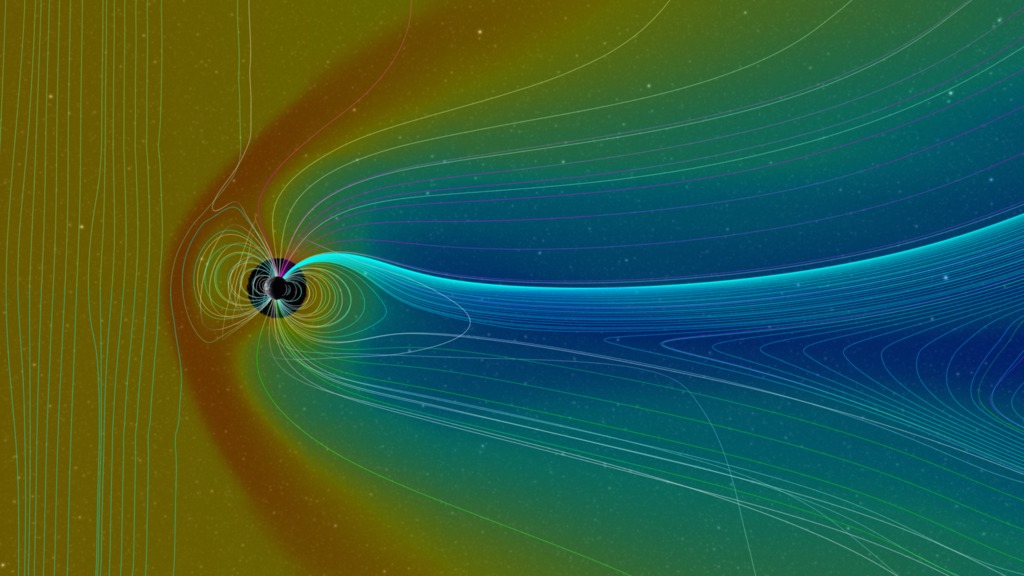Space Weather Event: The View from L1
We start from a position 'behind' the Earth, looking towards the Sun. From this position we see the orbit of the Moon as well as three of the heliospheric 'sentinels' (see "Sentinels of the Heliosphere"), ACE, SOHO, and Wind patrolling along 'halo orbits' (Wikipedia) around the Sun-Earth Lagrange Point, L1.
The CME (orange isosurface) erupts, heading towards the Earth. The density enhancement of the CME is visible in slice of data in the Earth's orbit plane which provides a better sense of when the CME actually reaches the Earth.
As the particle density enhancement from the CME strikes the Earth, we see the Earth's magnetosphere respond, with the outer, high density surface (red), 'blown away'. This surface location corresponds roughly to the location of the bow shock. The bow shock has not been eliminated, only some of its particles have been depleted, to be carried off in the CME and solar wind. As the densest material of the CME passes (orange surface), plasma from the CME continues to flow by the Earth, stretching the magnetosphere into a long, thin structure behind the Earth.
The magnetosphere slowly recovers from the 'impact', and regions that can confine higher particle densities reform - the red surfaces return. But not for long as the rarefaction behind the CME reaches the Earth. This lower density region provides fewer particles to repopulate the magnetosphere and make it easier for particles confined in the magnetosphere to 'leak' out into the solar wind.
For the BATS-R-US model, the isosurface colors are: red=20 AMUs per cubic centimeter, yellow=10.0 AMUs per cubic centimeter, light blue=1.0 AMUs per cubic centimeter, and blue=0.1 AMUs per cubic centimeter. An AMU corresponds to about the mass of a hydrogen atom, the dominant component of the solar wind.
This visualization is part of a series of visualizations on space weather modeling.
This is the full movie of the CME striking the Earth.

Opening view of the Earth, L1, Moon, and the satellite fleet, with the Sun in the distance.

The CME approaches the Earth.

The outer boundary of the CME begins striking the Earth's magnetosphere.

The CME has passed, with a portion in the distance from this view. The Earth's magnetosphere begins to recover from the 'impact'.
Credits
Please give credit for this item to:
NASA's Scientific Visualization Studio, the Space Weather Research Center (SWRC), the Community-Coordinated Modeling Center (CCMC) and the Space Weather Modeling Framework (SWMF), Enlil and Dusan Odstrcil (GMU).
-
Animators
- Tom Bridgman (Global Science and Technology, Inc.)
- Greg Shirah (NASA/GSFC)
-
Producer
- Scott Wiessinger (UMBC)
-
Scientist
- Michael Hesse (NASA/GSFC)
Release date
This page was originally published on Thursday, July 8, 2010.
This page was last updated on Wednesday, May 3, 2023 at 1:54 PM EDT.
Missions
This visualization is related to the following missions:Series
This visualization can be found in the following series:Datasets used in this visualization
-
SSCweb ephemerides (SSCweb)
ID: 538Satellite ephemerides
This dataset can be found at: http://sscweb.gsfc.nasa.gov
See all pages that use this dataset -
JPL/Horizon Orbital Ephemerides
ID: 597Planetary ephemerides
This dataset can be found at: http://ssd.jpl.nasa.gov/?horizons
See all pages that use this dataset -
Enlil Heliospheric Model (Enlil Heliospheric Model)
ID: 685MHD solar wind simulation
See all pages that use this dataset -
BATS-R-US Magnetosphere Model
ID: 686MHD Magnetospheric simulation
See all pages that use this dataset
Note: While we identify the data sets used in these visualizations, we do not store any further details, nor the data sets themselves on our site.
